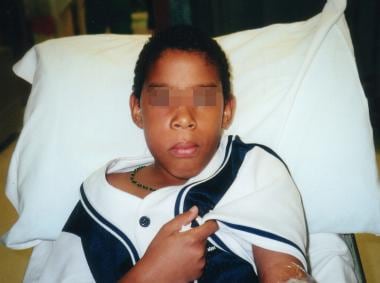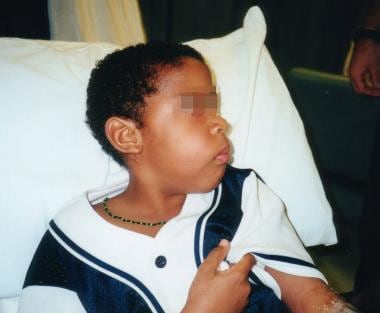Practice Essentials
Infections of the teeth have plagued humans constantly, despite a quest for better oral hygiene. As early as 200 BCE, a bronze wire root canal filling was found in the skull of a Nabataean warrior. Infections usually arise from pulpitis and associated necrotic dental pulp that initially begins on the tooth's surface as dental caries. The infection may remain localized or quickly spread through various fascial planes. See the images below.
Pathophysiology
Odontogenic infection may be primary or secondary to periodontal, pericoronal, traumatic, or postsurgical infections. A typical odontogenic infection originates from caries, which decalcify the protective enamel. A balance of demineralization and remineralization of the tooth structure occurs in the development of carious lesions. Greater demineralization of the tooth occurs with high bacterial activity and low pH. Greater remineralization occurs with a pH higher than 5.5 and high concentrations of calcium and phosphate from the saliva.
Bahl et al conducted a retrospective study to evaluate the involvement of fascial spaces, their bacteriology, sensitivity to antibiotics and management of odontogenic infection in 100 patients of age less than 60 years. The authors concluded that odontogenic infections were mixed aerobic-anaerobic infections. Anaerobic as well as aerobic cultures were necessary to isolate all pathogens. Successful management of these infections depends on changing the environment through decompression, removal of the etiologic factor and by choosing the proper antibiotic. [1]
Once enamel is dissolved, the infectious caries can travel through the dentinal tubules and gain access to the pulp. In the pulp, the infection may develop a track through the root apex and burrow through the medullar cavity of the mandible or maxilla. The infection then may perforate the cortical plates and drain into the superficial tissues of the oral cavity or track into deeper fascial planes. If the infection does not drain, it will remain localized and develop into a periapical or periodontal abscess.
Serotypes of Streptococcus mutans (cricetus, rattus, ferus, sobrinus) are primarily responsible for causing oral disease. [2] Although lactobacilli are not primary causes, they are progressive agents of caries because of their great acid-producing capacity.
Causes of dental infection include the following:
-
Serotypes of S mutans are thought to cause initial caries infection. Infections through the fascial planes usually are polymicrobial (average 4-6 organisms). Dominant isolates are anaerobic bacteria.
-
Anaerobes (75%) - Peptostreptococci, Bacteroides and Prevotella organisms, and Fusobacterium nucleatum
-
Aerobes (25%) - Alpha-hemolytic streptococci
Epidemiology
United States statistics
Dental caries is the most common chronic disease in the world. The late 1970s signaled a decline in caries in certain segments of the world due to the addition of fluoride to public drinking water. In the United States, a 36% decrease in caries occurred from 1972-1980.
International statistics
In the United Kingdom, a 39% decline in caries occurred from 1970-1980. In Denmark, a 39% decline occurred from 1972-1982. [3]
Age-related demographics
The National Preventive Dentistry Program found that 60% of caries occurred in 20% of children, who were generally minorities or of lower socioeconomic status. [4]
Prognosis
Morbidity/mortality
Dental caries is not a life-threatening disease; however, if an odontogenic infection spreads through fascial planes, patients are at risk for sepsis, airway compromise (eg, Ludwig angina, retropharyngeal abscess), and odontogenic infection, which accounted for 49.1% of the deep neck abscesses in one study. [5]
Patients with neutropenia undergoing chemotherapy are at risk for certain pathogenic oral microorganisms that cause bloodstream infections, which increases the chance of morbidity and mortality. Odontogenic infections carry significant morbidity of pain and cosmetic defect. The US bill for dental care was estimated at $27 billion in 1985. The oral cavity contains approximately 30-50% viridans group streptococci that are resistant to penicillins and macrolides.
Complications
Complications of dental infections include the following:
-
Abscess
-
Sepsis
-
Obvious swelling of the right cheek.
-
Side view. Fluctuant mass extending toward the buccal side of the gum end to the gingival-buccal reflection.







